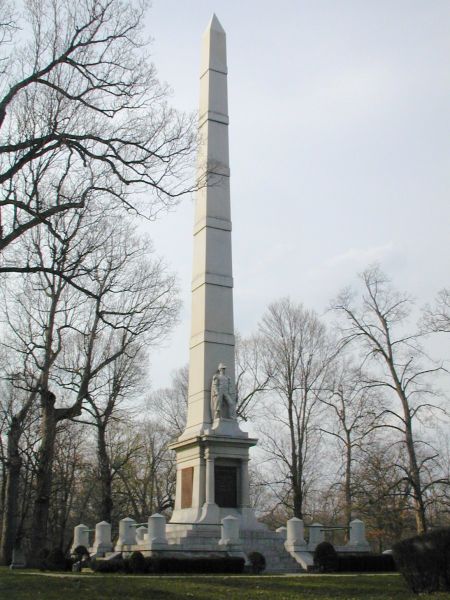Battle of Tippecanoe Memorial (Battle of Tippecanoe Memorial)

Concerned about the possible extinction of their race brought on by advancing expansion of white settlers into the midwest, the Shawnee chief Tecumseh and his brother, Tenskwatawa (The Shawnee Prophet) left their native Ohio and, with permission of the Potawatomi and Kickapoo tribes, established Prophet’s Town in 1808 to serve as a capital of a great Native American confederacy. Through this union, the Native Americans could successfully defend themselves. Prophet’s Town became a training center for as many as one thousand resident warriors. The white settlers of the Indiana Territory were disturbed by the increasing activities and power of Tecumseh and his followers. In the late summer of 1811, the governor of the territory, General William Henry Harrison, organized a small army of 900-1000 men, hoping to destroy the town while Tecumseh was on an extended recruitment drive in the southern states. Soon after their arrival at a site near Prophet’s Town, Harrison’s encampment was attacked by a Native American army, under the encouragement of the Prophet, at 4 o’clock on a cold raining morning of November 7, 1811. After a three hour engagement, the Native American army was defeated. Prophet’s Town was destroyed the following day and Tecumseh’s dream of a great Native American confederation was extinguished. This set the stage for accelerated western expansion of white settlers. More than fifteen counties in the state of Indiana have been named in honor of soldiers who participated in the Battle of Tippecanoe. On May 29, 1840 William Henry Harrison returned to the site for the first major political rally for his successful Presidential campaign. “Tippecanoe and Tyler, too” was a catchy slogan that was inaugurated here. The Shawnee Prophet placed a curse on Harrison that he would die in office and “after him, every Great Chief chosen every 20 years thereafter will die. And when each one dies, let everyone remember the death of our people.” Prior to his curse, no U.S. President had ever died in office. The curse appears to have affected Presidents Harrison, Lincoln, Garfield, McKinley, Harding, Franklin D. Roosevelt and Kennedy. It appears that the curse pursued Ronald Reagan, who survived serious wounds of an assasination attempt and may have broken the curse. The winner of the 2000 election, George W. Bush, may yet be subject to the curse and will help determine that. In the year following the battle, the graves of those buried at the site were found and disturbed by Native Americans. The following year, a General Hopkins found the scattered remains and reinterred them. In the spring of 1830, the remains were collected and placed in one grave at the site. In 1908, an 85-foot marble obelisk was erected at the site. Cenotaphs were placed at the sites where officers Colonel Abram Owen, Major Joseph Daviess, Captain William Baen, Captain Spier Spencer, Captain Jacob Warrick, Lieutenant Thomas Berry and Lieutenant Richard McMahon were killed in the conflict. (W. Barrett). Cause of death: Casualty of war
Born
- January, 01, 1970
- unknown
Died
- January, 01, 1970
- unknown
Cause of Death
- Casualty of war
Cemetery
- Tippecanoe Battlefield Memorial
- Indiana
- USA

